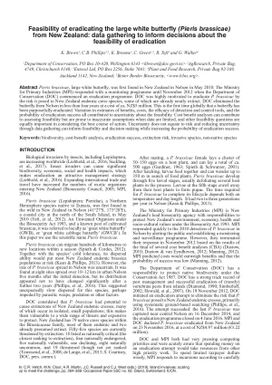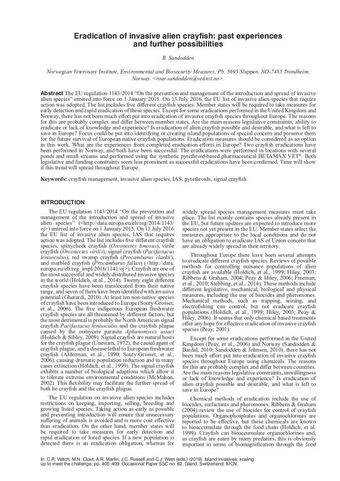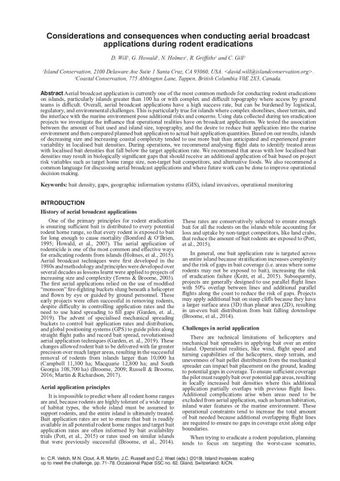Feasibility of eradicating the large white butterfly (Pieris brassicae) from New Zealand: data gathering to inform decisions about the feasibility of eradication
- Description:
- Pieris brassicae, large white butter?y, was ?rst found in New Zealand in Nelson in May 2010. The Ministry for Primary Industries (MPI) responded with a monitoring programme until November 2012 when the Department of Conservation (DOC) commenced an eradication programme. DOC was highly motivated to eradicate P. brassicae by the risk it posed to New Zealand endemic cress species, some of which are already nearly extinct. DOC eliminated the butter?y from Nelson in less than four years at a cost of ca. NZ$5 million. This is the ?rst time globally that a butter?y has been purposefully eradicated. Variation in estimates of bene?ts, costs, the e?cacy of detection and control tools, and the probability of eradication success all contributed to uncertainty about the feasibility. Cost bene?t analyses can contribute to assessing feasibility but are prone to inaccurate assumptions when data are limited, and other feasibility questions are equally important in considering the best course of action. Uncertainty does not equate to risk and reducing uncertainty through data gathering can inform feasibility and decision making while increasing the probability of eradication success.
- Display date:
- 2019
- Collections:
- Secretariat of the Pacific Regional Environment Programme (SPREP)
- Publisher:
- International Union for Nature Conservation (IUCN)
- Content partner:
- Secretariat of the Pacific Regional Environment Programme (SPREP)
- Availability:
- Not specified
-
Copyright status: All rights reservedFind out more about what you are able to do with this itemThis item is all rights reserved, with means you'll have to get permission from Secretariat of the Pacific Regional Environment Programme (SPREP) before using it. For more information, please see our use and reuse page.What can I do with this item?Non-infringing useNZ copyright law does not prevent every use of a copyright work, and this item may be hosted by an international institute or organisation. You should consider what you can and cannot do with a copyright work.No sharingYou may not copy and/or share this item with others without further permission. This includes posting it on your blog, using it in a presentation, or any other public use.No modifyingYou are not allowed to adapt or remix this item into any other works.No commercial useYou may not use this item commercially.
Related items
Welcome and warm Pasifik greetings
The information on this site has been gathered from our content partners.
The names, terms, and labels that we present on the site may contain images or voices of deceased persons and may also reflect the bias, norms, and perspective of the period of time in which they were created. We accept that these may not be appropriate today.
If you have any concerns or questions about an item, please contact us.


